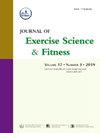蓝光和红光照射对认知表现、运动能力、感知努力和动态平衡的急性影响:一项随机交叉研究
IF 2.4
2区 医学
Q2 SPORT SCIENCES
引用次数: 0
摘要
本研究探讨了窄带蓝光(460 nm)和红光(630 nm)照射对健康年轻男性认知能力、运动能力、感知疲劳和动态平衡的急性影响。据我们所知,这是第一个随机交叉研究,系统地评估运动前光照对运动背景下认知-运动整合和有氧表现的综合影响。方法采用随机交叉设计,选取50名体力活跃的年轻男性。参与者被暴露在蓝光或红光下,随后立即评估简单反应时间(SRT)、增量穿梭行走测试(ISWT)距离、心率、感知运动和y -平衡测试的表现。结果蓝光照射可显著改善SRT (Δ =−53.33 ms; p < 0.001, η2p = 0.270),增强动态平衡。红光照射使ISWT距离增加(Δ = +36.98 m; p = 0.004, η2p = 0.453),感觉疲劳和呼吸困难明显减少。蓝光下SRT改善与ISWT距离呈正相关(β = 0.1869, p = 0.008)。该研究表明,短期特定波长的光照射可以优化运动前的认知和生理准备。这些发现提供了新的证据,支持在运动准备方案中整合个性化的基于光的策略。本文章由计算机程序翻译,如有差异,请以英文原文为准。
Acute effects of blue and red light exposure on cognitive performance, exercise capacity, perceived effort, and dynamic balance: A randomized crossover study
Background
This study investigated the acute effects of narrow-band blue (460 nm) and red (630 nm) light exposure on cognitive performance, exercise capacity, perceived fatigue, and dynamic balance in healthy young males. To our knowledge, this is the first randomized crossover study to systematically assess the combined impact of pre-exercise light exposure on both cognitive-motor integration and aerobic performance within an exercise context.
Methods
Fifty physically active young males participated in a randomized crossover design. Participants were exposed to either blue or red light, followed immediately by assessments of simple reaction time (SRT), Incremental Shuttle Walk Test (ISWT) distance, heart rate, perceived exertion, and Y-Balance Test performance.
Results
Blue light exposure led to a significant and large improvement in SRT (Δ = −53.33 ms; p < 0.001, η2p = 0.270) and enhanced dynamic balance. Red light exposure produced greater increases in ISWT distance (Δ = +36.98 m; p = 0.004, η2p = 0.453) and significant reductions in perceived fatigue and dyspnea. A moderate positive correlation was observed between SRT improvement and ISWT distance under blue light (β = 0.1869, p = 0.008).
Conclusion
This study demonstrates that short-term, wavelength-specific light exposure may optimize both cognitive and physiological readiness prior to exercise. These findings provide novel evidence supporting the integration of individualized light-based strategies in athletic preparation protocols.
求助全文
通过发布文献求助,成功后即可免费获取论文全文。
去求助
来源期刊
CiteScore
5.10
自引率
3.60%
发文量
54
审稿时长
31 days
期刊介绍:
The Journal of Exercise Science and Fitness is the official peer-reviewed journal of The Society of Chinese Scholars on Exercise Physiology and Fitness (SCSEPF), the Physical Fitness Association of Hong Kong, China (HKPFA), and the Hong Kong Association of Sports Medicine and Sports Science (HKASMSS). It is published twice a year, in June and December, by Elsevier.
The Journal accepts original investigations, comprehensive reviews, case studies and short communications on current topics in exercise science, physical fitness and physical education.

 求助内容:
求助内容: 应助结果提醒方式:
应助结果提醒方式:


